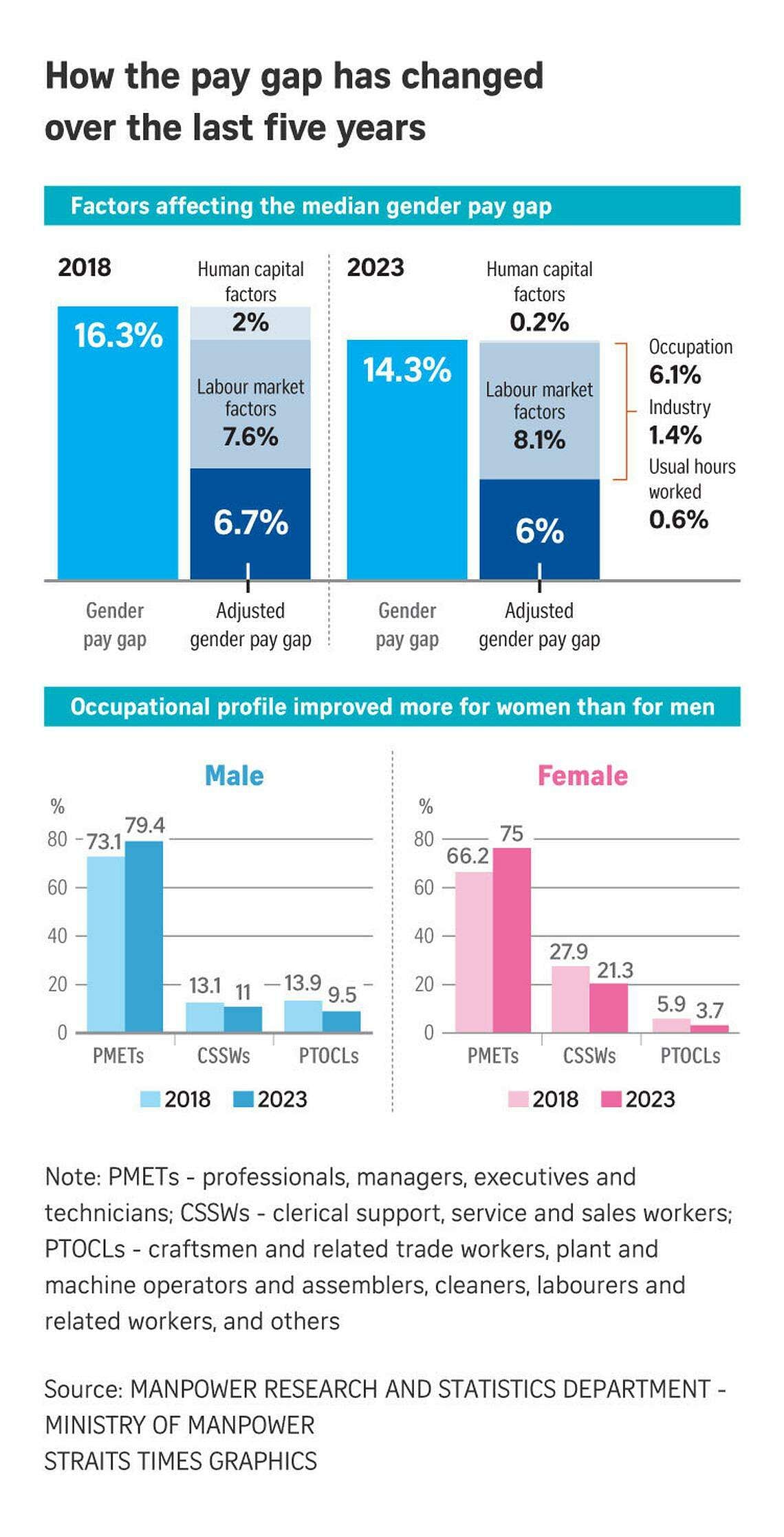SINGAPORE - Singapore has made strides in raising employment opportunities for women, though they are still earning less than men.
The median income for women working here was 14.3 per cent less than that for men in 2023, a narrower gap than the 16.3 per cent in 2018, according to the latest Ministry of Manpower (MOM) data.
The gender pay gap refers to the difference in the median income for female and male employees expressed as a percentage of the median income of male employees. For MOM’s study, the incomes of employees aged 25 to 54 who are Singaporean or permanent residents and working full-time were analysed.
Singapore’s pay gap was slightly worse than that across Organisation for Economic Cooperation and Development (OECD) countries, which was 12.1 per cent in 2022. But the OECD data also shows the Republic did better than countries like the United States (17 per cent in 2022), Britain (14.5 per cent) and Japan (21.3 per cent).
Differences in occupation between men and women remained the key factor influencing the gender pay gap in 2023, among the various factors examined, said the ministry. One way this comes into play is where men are overrepresented in higher-paying occupations.
However, from 2018 to 2023, the gender pay gap narrowed as the occupational profile of females improved more than that of men, said MOM in an infographic released on its website on March 4.
A total of 75 per cent of women in 2023 were working in professional, managerial, executive and technician (PMET) jobs, an 8.8 percentage point increase from 2018. On the other hand, the proportion of men in PMET jobs increased by 6.3 percentage points in the same period to 79.4 per cent.
Besides occupation, other labour market factors that contributed to the gender pay gap are differences in industries and weekly working hours. Human capital factors of age and education play a much smaller role.
After removing the effects of occupation and other labour market and human capital factors, Singapore’s adjusted gender pay gap in 2023 was 6 per cent, down from 6.7 per cent in 2018.
This means a woman could be working in the same job as her male colleague, in the same industry, at the same age and education level, but for lower pay.
An earlier 2020 report on the gender pay gap had stated the adjusted pay gap in 2018 as 6 per cent. MOM explained that the model to calculate this has been revised using the latest occupational classification, SSOC 2020.
The pay gap that remained after the adjustment could reflect the effects of parenthood; caregiving responsibilities; and unmeasured employment characteristics such as work experience, firm type, and job scope; as well as discrimination, said MOM’s report.
Mr Samuel Sobrielo, the Institute for Human Resource Professionals’ deputy director for professional practices and community, said career breaks may be one reason the pay gap persists.
“Fundamentally, pay must be a function of experience, skills, performance and the value an individual can bring to the job – factors which can be attributable to time spent in the workforce,” he said.
“With the likelihood of women assuming the primary caregiving responsibilities, it may necessitate them taking breaks from employment, hence ‘delaying’ work experience, which may consequently impact the salary.”

Ms Betul Genc, senior vice-president and head of Asean at recruitment firm Adecco, said: “Even though we observe less and less practice in the market, it is worthwhile to acknowledge that some organisations might offer men higher starting salaries to compensate for national service, which in the long run creates the pay gap.”
A recent survey suggests some women feel they are not being compensated fairly for work.
Some 37 per cent of women polled felt that a gender pay gap exists in Singapore, said a report put out in March by job search platform Indeed.
This proportion, however, was the lowest out of 11 countries surveyed. The global average figure was 57 per cent, with Italy and France having the highest proportion of women – 70 per cent and 68 per cent, respectively – who felt that there was an unfair difference in the pay of men and women.
Other countries surveyed include the United States, Britain, India, Australia and Japan.
The study in November 2023 polled 14,677 women in either full-time or part-time employment, including 1,196 in Singapore.
A total of 59 per cent of women here said they were not paid enough base salary, while 33 per cent felt they were paid the right amount.
Despite this, only a third of the respondents here have asked for a raise during their careers. Worry about negative consequences was the top reason cited, while some said they did not have enough confidence or did not think asking for a pay rise was an option.
When it comes to career progression, women in Singapore are in line with the global average in their belief that it is easier for men than women to progress in their careers, said the report. A total of 43 per cent of women here felt that way.
The top reasons they cited for this perceived challenge were sexism or unconscious bias in society (56 per cent) and caregiver responsibilities (54 per cent).
In another survey, recruitment firm Hays said 31 per cent of Singapore workers felt that more needed to be done to ensure women had equal opportunities for workplace participation, higher than the Asian average of 19 per cent.
This was based on a poll conducted in February 2024 among more than 500 workers in Asia, it said on March 6.
Human resources (HR) experts told The Straits Times that increased awareness and advocacy for diversity and inclusion at the workplace, as well as initiatives such as flexible work arrangements and programmes to encourage women to take up careers in Stem (science, technology, engineering and mathematics), have helped narrow the gender pay gap in Singapore. But more can be done to tackle gender bias at work.
“HR professionals have to play a more strategic role to reduce any disparity in pay due to gender. It is paramount that compensation is based on merit, skills, experience and performance and HR has to ensure that this sacrosanct principle is upheld,” said Mr Sobrielo.
Mr John Borneman, regional director at Hays Singapore, suggested that employers consider tailoring flexi-work options to what is really needed by groups of workers deserving of equity, instead of implementing blanket policies.
For women, for example, flexibility around caregiving and maternity is a significant driver to equal participation, he said.
Ms Nishita Lalvani, Indeed’s marketing director for India and South-east Asia, said: “Achieving gender parity requires significant work in three key categories: salary and compensation, career progression, and well-being.”
Employers could disclose pay structures within their organisations and include salary or salary ranges on job postings, said Indeed’s report.
They can also create a task force to foster diversity, equity, inclusion and belonging at the workplace, provide training on unconscious biases and provide mentorship and allyship programmes.
Ms Lalvani added: “Employers in our region need to understand how highly female employees value a positive work culture, work-life balance and job security. Understanding these factors and implementing them will be the first step in helping improve the job satisfaction of this key demographic.”


